Magnolia Wood
Your artistic journey includes ballet, fashion, and theatre. How do these disciplines influence your painting practice today?
All these disciplines have in common that they form an expression of the self, although some in more direct form and some more indirect via a medium or predefined form. My painting practice is largely a form of self- expression too. Further, a few of my works have direct reference to some of these disciplines as well.
The first example of direct reference to the theatre discipline is a painting called: ‘Godot never came’, which depicts a teary-eyed woman dressed like Marylin Monroe, taking off her makeup after a theatre performance is over, with a background reference to a common ‘Waiting for Godot’ theatre play stage scenery. Here I used the references of this theatre play and a woman taking off her makeup mask of a Hollywood icon as a visual reference to depict a feeling of lost hope. A breaking down of a promise, or a wished-for expectation which was never fulfilled. This is in fact also the theme of the theatre play, which has two men waiting for a third man called Godot. It never becomes clear if this 3rd person is a real person or a symbolical part of themselves, a hope, or a dream. The 3rd man never shows up. This is one of the examples from my work to say that I sometimes use references from these art disciplines also directly to add depth to the images I create. If the viewer has some knowledge on these artistic disciplines they may be able to grasp some of the references, although I hope that the general feeling of disappointment and a break-down of glamour or keeping up appearances is also recognizable without understanding the theatrical references.
A second example of direct reference to the fashion discipline is the painting: ‘At the catwalk’, in which I created a somewhat surreal scene of a fashion catwalk with its models on show, its viewers and reporters, obsessively looking through- and using their phones and cameras to capture images of the event, all in a light pinkish/lilac environment which creates a dreamy, alienated and artificial atmosphere, which can be the case at times with fashion shows in a world of make believe and where to see and be seen is of major importance.
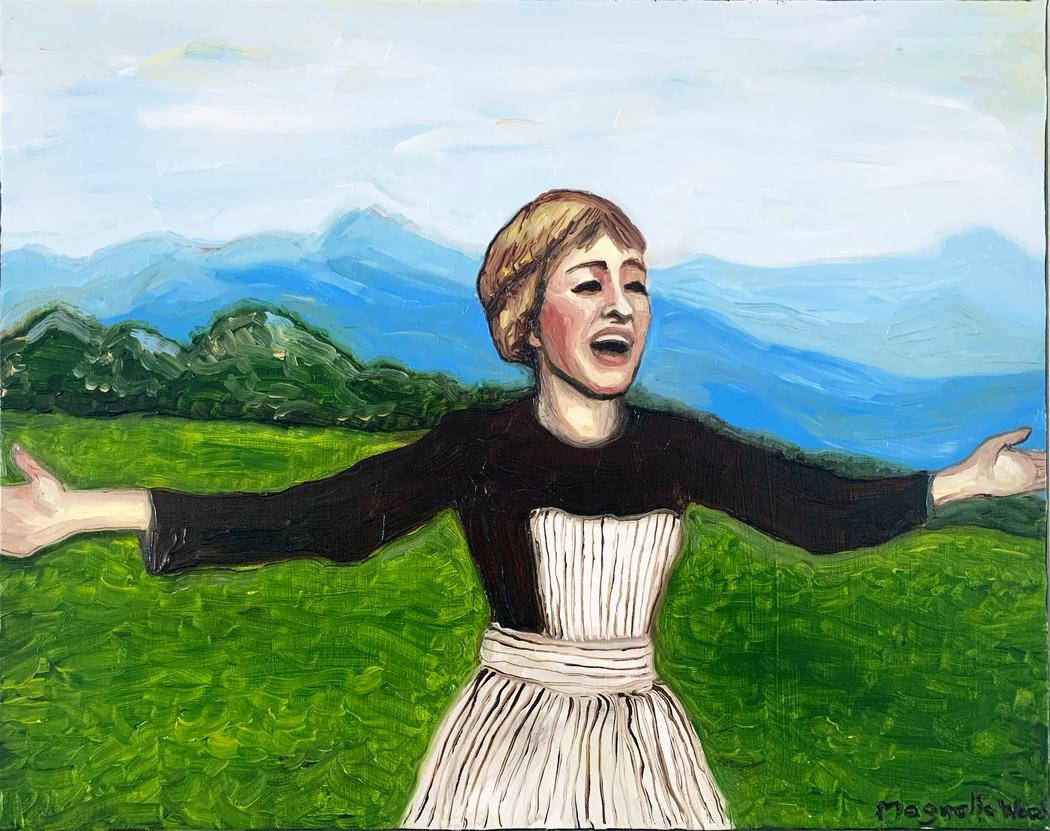 Magnolia Wood | The Sound Of Cries | 2025
Magnolia Wood | The Sound Of Cries | 2025
You mention starting with reference images but not aiming for direct likeness. Can you describe your process of translating an image into something more emotionally ambiguous?
Yes, in many cases I indeed do not aim for direct likeness as my art generally is less about a certain person but is more about human experience in general.
Sometimes a human figure is part of a landscape or scene and sometimes it can be the main topic of a painting, but it could be an imaginary person. An example of the latter is the painting: ‘Lizzie’s laugh’, 1 of 6 of my ‘Happy series’. Here I looked for images of people that express a form of happiness, as a study of what happiness looks like, reflected in bold uplifting and neon colour paintings with a clear black lining. Quite a direct expression of the emotion of joy and happiness. The paintings are not a direct likeness to the images I found, (the facial shapes are i.e. a bit different then the original photo) and even the names in the series, like ‘Lizzie’, are made up. I gave some of these imaginary characters names to make it a more personal experience looking at it. However, this laughing girl child could for example be anyone’s’ niece, (grand)daughter, sister etc. The goal was to create a relatable series of portraits of people expressing happiness, which could have been anyone in our direct environments.
In some cases, I do use direct likeness, if I think it is important for what I want to say with a work, such as a reasonable direct likeness to Audrey Hepburn and Uma Thurman in the paintings: ‘Audrey in pain’, or ‘Kill em, Uma’. In these cases, the resemblance to these iconic figures is relevant (at least enough to tap into shared visual memory). They convey a message and connect with our universal public memory of these Hollywood stars and what they stood/stand for (kindness, grace, beauty, vulnerability and strength) and in the case of the Uma painting there is also reference to a particular movie scene of ‘Kill Bill’ which is relevant for the works’ messaging. Some of the other paintings in the series also relate to other shared visual memories, artists and artistic scenes, such as relations to Julie Andrews in the Sound of Music, Pipilotti Rist, Banksy, and the 2025 winning song of the Eurovision song festival by the Austrian singer JJ. They altogether symbolize different elements of (struggles) with kindness and love where kindness is not returned, or trust is broken.
So, in summary, where I do create direct likeness, it is mostly to tap into shared memory (but the faces may be somewhat altered, yet enough for recognition). But most often I use reference images with a human figure on it, without creating direct likeness to that specific human figure in the painting. The figure is then painted as part of the message/experience I want to convey, which could relate to you, me, or anyone. That is why it is not important which human figure it is in the painting.
The figures in your paintings are expressive, often with dramatic gestures or gazes. What role does the human figure play in your storytelling?
Although I also create landscapes, scenes and still life paintings without any people in them, very often one or multiple human figures do appear in my paintings. I would say that roughly all my paintings are related to human emotion, human condition, states of being, or things, places, animals, shared (pop)culture or visual memories that stand in relation to us human beings.
When I do display human figures in my paintings, this often comes from a wish to strengthen the sensation of the relation of the human figure to its surroundings. For example, in a series of 3 paintings: ‘Coming out of the woods’ with each a human figure (non-recognizable) depicted in three wood scenes, referencing a transcendental journey through the woods. You could see the painted landscape and the figures in it, their placement in the composition, and colour palettes used all as a representation of an inner journey, which could relate to any of us.
In another recognizable human figure example and their function in the storytelling, we can talk about the painting: ‘The sound of cries’, (4/5) in the series: ‘Kindness has (no) limits’. Here you see a Julie Andrews’-like type of figure in an iconic scene from the movie the ‘Sound of Music’. In the film she sings beautifully up in the mountains, which is a rather freeing scene. In this painting, I found the reference to her and this iconic movie scene image relevant to present it in recognizable manner with a twist. With her as an iconic statute of elegance, charm and kindness, however now ‘freeing’ herself with sounds of cries, out into the abyss of the open fields and mountains. This is something maybe rather unexpected in relation to how we remember her character, as her face in my painting somehow misses her charming upbeat sparkle but instead shows signs of torment or inner struggle. Her open arms and wide-open mouth now suggest an emotional sound release which lacks the charm of the beautiful songs she sang in the movies and would present a less polished cry out. It is mixing something familiar with something less familiar to bring the viewer in. The initial recognition and variation to it may create a more human all-rounded picture of a picture-perfect character.
Even some of my paintings with no human figures in them, have reference to a human figure who was, will be or might have been there. In for example my Japan series, there is a painting: ‘An ode to geishas entertaining behind closed doors’, 5/5. In this painting you see a scene of a carefully made table with Japanese dishes, sake bottle, plates, bowls, eating sticks etc. It has no human figure depicted in it. It adds to the storytelling, as geishas often are not visible to everyone when they prepare and serve the meals, and conduct their performances in its traditional form in old Japanese teahouses etc. Therefore, there is also no geisha depicted in the scene, but you can get a sense of her presence.
When human figures are displayed without any or very little resemblance to any recognizable figure, it is mostly to say: ‘this could be you, this could be me, this could be someone you know’. And even when I do reference recognizable human figures, I often look for a new way to look at them and ‘make them more human’ as icons at times provide a limited dimension view to their personality.
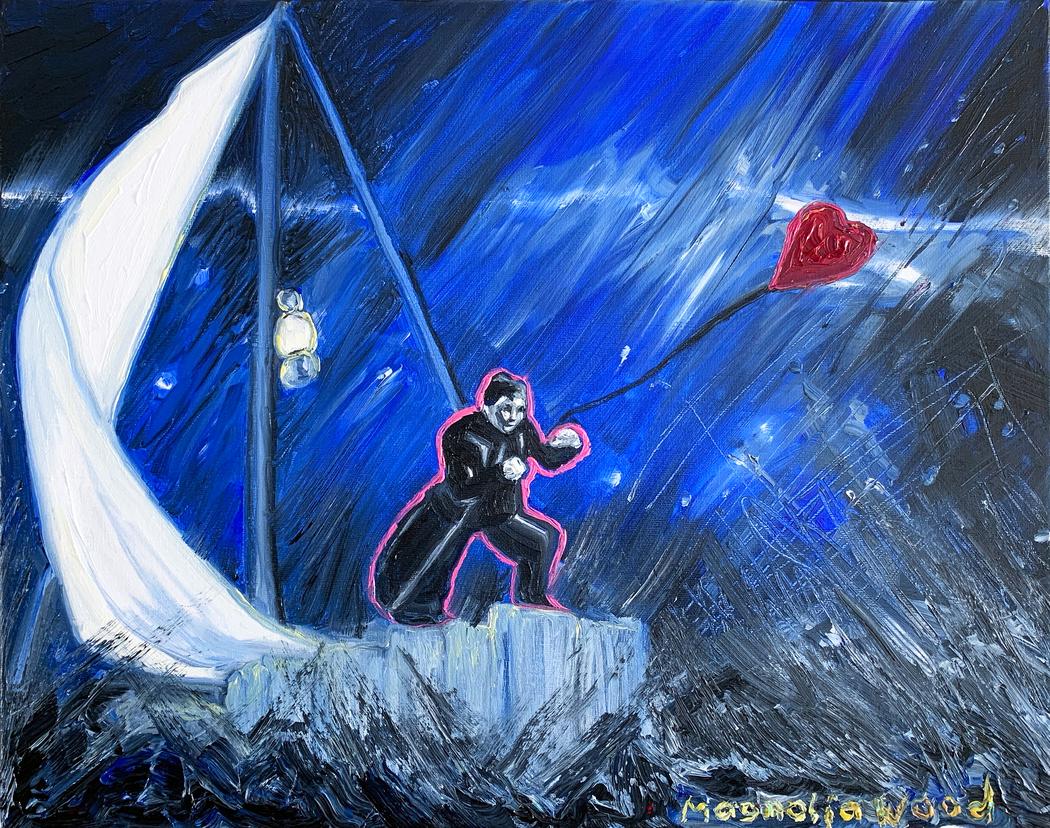 Magnolia Wood | The World Can Be A Wasted Place | 2025
Magnolia Wood | The World Can Be A Wasted Place | 2025
Colour plays a powerful role in your paintings—how do you choose your palette? Is it intuitive or symbolic?
Yes, colour is indeed very important in my paintings. I would say it is more intuitive how I choose my palette, but it ends up strengthening some symbolic values in the works moreover. As my paintings mostly reflect states of being, emotions, memories and atmospheres, I believe colour plays an important role in that, as colours are known to evoke emotions and can strengthen or underpin emotional state representations or create associations. However, at times, it can also be fun to play with that and go more counter the obviously fitting colours. Sometimes I also experiment using a limited colour palette just to challenge myself and give a new dimension to my work. As such the painting: ‘On the rocks’ is made with the limited colour palette of blue, white and black, and ‘Marylin with a bike’ is made with only white and black. I would say that I always choose the colour palette to fit the atmosphere or visual storytelling I want to create.
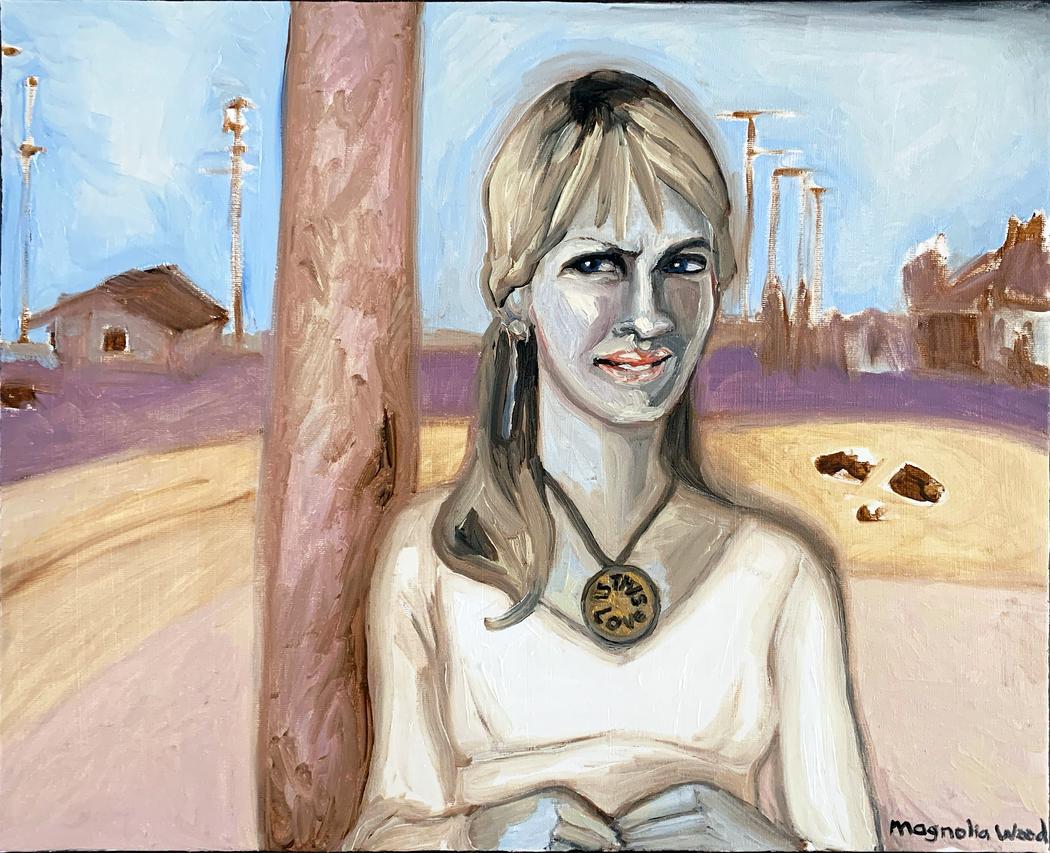 Magnolia Wood | Kill’Em Uma | 2025
Magnolia Wood | Kill’Em Uma | 2025
How do you balance clarity and vagueness in your compositions to evoke introspection without giving too much away?
In general, I find that more vagueness evokes more of a feeling of a memory (as also memories fade or get blurred from memory) stimulating a reflective state and clarity creates a more direct experience. I play quite a bit with these elements and at times create entire series with a lot of vagueness as well as series which lean towards much clarity, or a mix of the two outer ends combined in one painting or painting series.
Mostly I decide the level of clarity and vagueness during the creation process, as I try to determine which in that spectrum will have the best effect on the atmosphere and visual storytelling I want to achieve with the painting. Sometimes a rougher and more wiped out, ‘dirty’ or dreamy look (as you can see for example in my ‘Bob Dylan and me’ and ‘Let’s have fun’ series) can better fit with the theme and gut feel I would like to achieve. Whereas other times, clarity is important for reference to specific iconic elements, or to promote a more direct or confrontational experience. Some of my paintings are direct and clear in style and gestures but find more nuanced meaning in sub-messages though depicted element and titles. Lastly, I play with combinations where I decide to leave parts of a painting vaguer or fill them in with abstracted gestures, whereas the rest of the painting has more clarity in style. This is to leave some parts for guessing adding to the mystery of the painting, or I use clarity versus vagueness to direct the focus of the viewer and create purposeful contrast. An example of the latter is: ’The world can be a wasted place’ 5/5 painting from the ‘Kindness has no limits’ series. Here, the key human figure in the middle and the sails of his fort both trying to fight the storms, are painted with clarity. An additional focus is brought onto the human figure through a pink line surrounding his profile, whereas the stormy surroundings are painted with more vagueness, roughness, textured brushstrokes and scribblings onto the canvas to show the contrast of the central human figure with its distorted and chaotic environment.
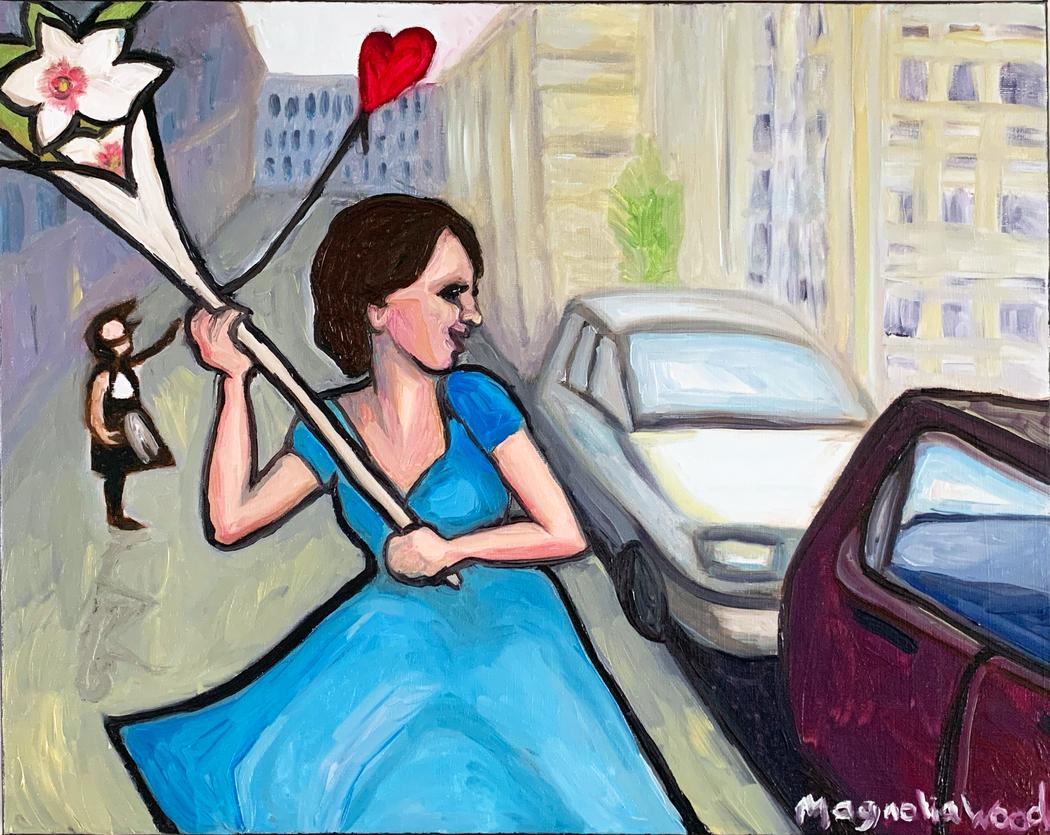 Magnolia Wood | Pipilotti Flower Thrower | 2025
Magnolia Wood | Pipilotti Flower Thrower | 2025
Some of your works seem to reference iconic images or characters. What is your approach to using visual memory and cultural references in your work?
Indeed, in some series I do use iconic images or characters. I already talked a bit about the use of some of those in the series of ‘Kindness has (no) limits’ where I used them as ambassadors of visual shared memory of Hollywood stars or artists who can be associated with characteristics like charm, grace, kindness and a certain vulnerability. To then use these iconic elements as a starting point for relatability whilst at the same time referencing to struggles with these traits of kindness they are so well known for and providing hints for unseen or ‘under the surface’ struggles or emotions. The key point of struggle is about when one is always trying to be kind to others, and what happens when such kindness is not met back with kindness, and boundaries are violated. Can, and should one remain kind? What about the needs to be seen, heard, felt, understood? Can we all see through the brave fight of a kind fighter and make room for ‘unkind’ feelings to bubble up? May sadness, anger, frustration be experienced, also by heroes in our public domain that stand for other values?
Besides the before mentioned series, I also created a series of works with direct reference to iconic female characters from history till now which are all inspired by remarkable women. Here I was looking for women role models, or the ones (role model or not) who have left an imprint throughout modern- and past times, to honour them. This served both as a reminder and inspiration to me and to others that any of us can create our own legacy to be remembered.
Further, I have also used iconic females depicted in historic paintings as a starting point for new contemporary work, such as the painting: ’Modern Madonna’, inspired by the ‘Madonna’ painting by Edward Munch. In my version of the painting, I focus on her face instead of her full nakedness, creating an ambiguous modern Madonna whose expression is rather complex to read and leaves room for guessing. Here, I used this reference for a modern version of Edward Munch’s soul paintings, which one could see as a comment to the soul and state of a modern woman.
What do you hope a viewer feels or reflects on when encountering your paintings?
I am hoping for a shared experience. In that, some of the feelings, atmospheres or messages which were part of my personal process when painting them, would seep through to the viewer. At the same time, I hope that my paintings provide an open-ended story to which the viewer can feel invited to supplement their own feelings, reflections, memories and stories to emerge to the surface. They are free to complete and finish the elements of a story that my painting would provide them with their own thoughts and experiences. They are invited to experience their reflections in that moment without judgement. Their experience could also (in part) be different from the intention I made the paintings with, as I do not want to dictate the experience. My paintings provide a mixed pallet of emotions, stories and messages/themes to experience, such as: fear, loneliness, companionship, joy, anger, rage, tension, sadness, mourning, acceptance, serenity, tranquillity, peace, excitement, social community, instability, seeking, finding, disappearing, vulnerability, recovery, surprise, uncomfortability, wonder, curiosity, wit, exploration, charm, admiration, luxury, hiding, climbing, overcoming, daily rituals, subliminal messages or symbolism, encounters, relationships, art for art, self-discovery, shared events and places, hope, faith, freedom, liberation, time passing, disappointment, sensory experiences, sensuality, love, romance, love for life, death, memory, shadow work, multidimensionality, conflict, forgiveness, repressed and released emotion, dreamscapes etc.
Most of all, I would hope a viewer can be inspired and comforted when encountering my paintings by giving them a space for reflection and a moment to themselves, allowing them to have bubble up what is relevant in the moment.

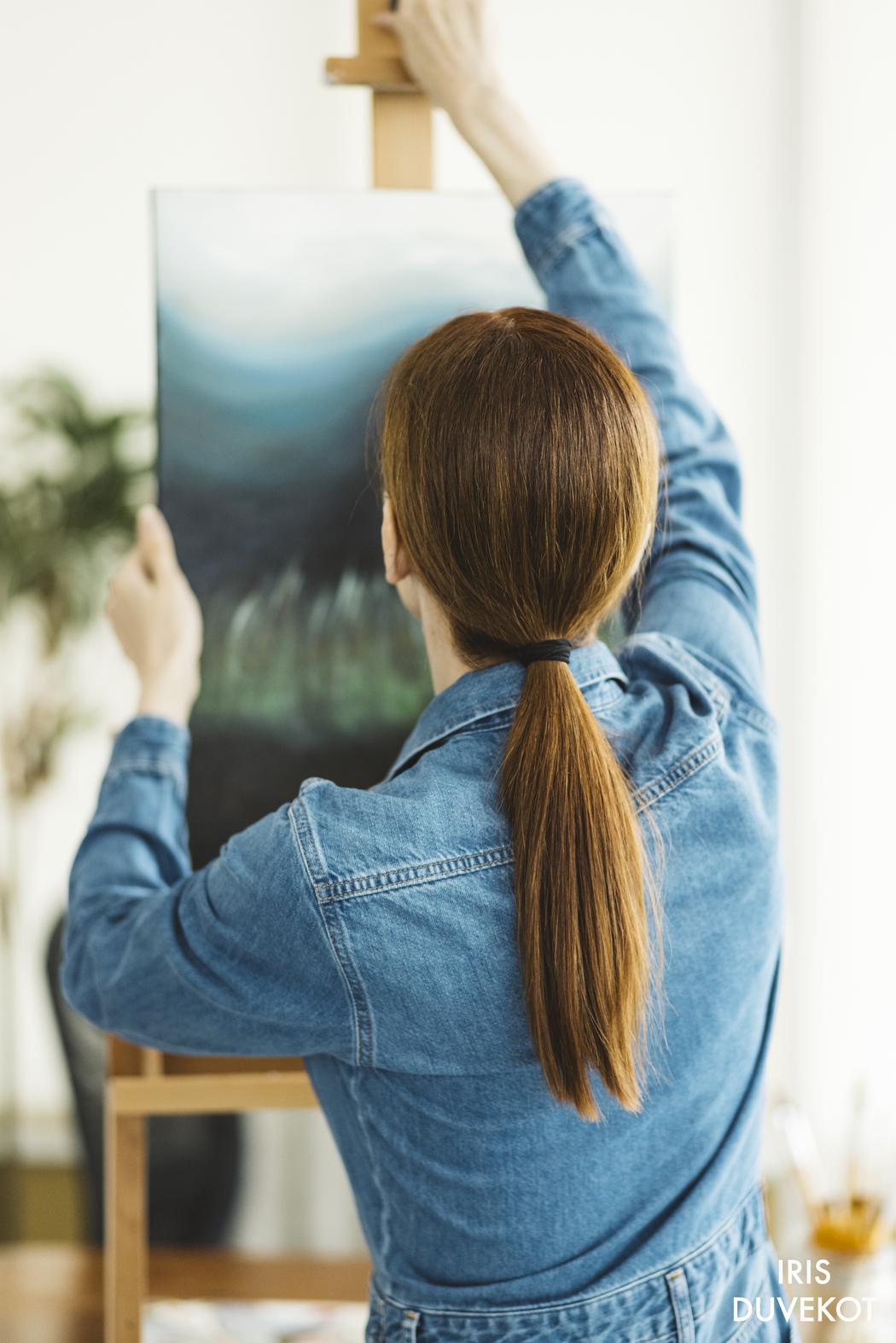
Leave a Reply
You must be logged in to post a comment.